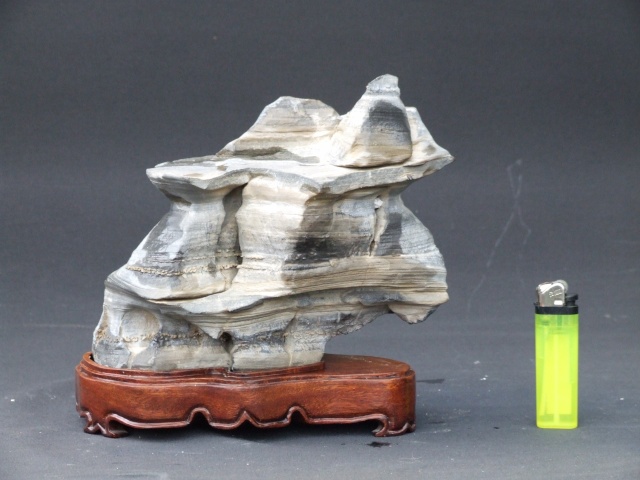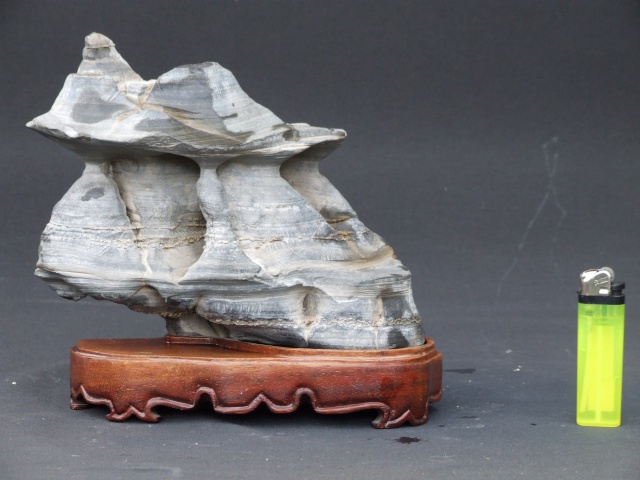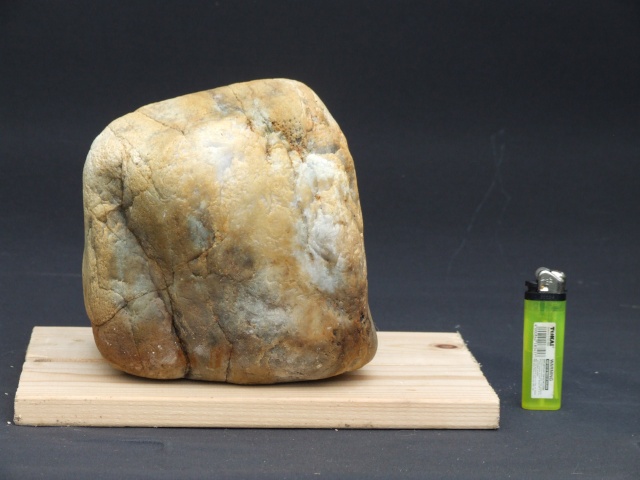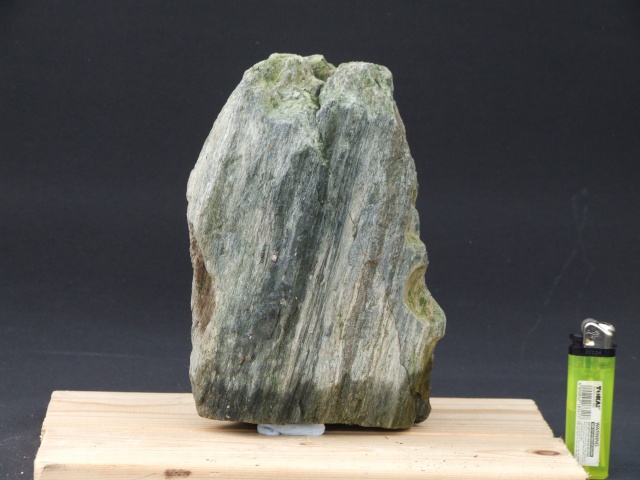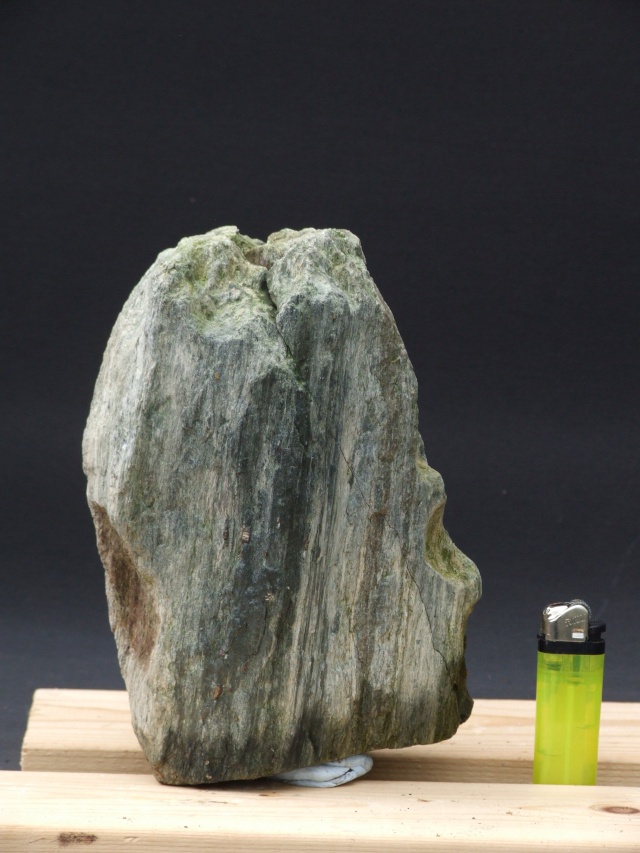Stones for beginners
+2
ogie
fiona
6 posters
Page 1 of 2
Page 1 of 2 • 1, 2 
 Stones for beginners
Stones for beginners
I hope everyone is sitting comfortably because this might be the longest introduction to a thread yet.  Here goes anyway:
Here goes anyway:
A week or so ago I put on a thread asking a question about what to look for in a stone. Although I received a great answer from Sunip (Thanks, Sunip ), I felt that the question I had asked was far too vague and gave the impression that I was only asking about the type of image (animals, human forms etc) one should see when looking at a stone - in other words the stone appreciation side.
), I felt that the question I had asked was far too vague and gave the impression that I was only asking about the type of image (animals, human forms etc) one should see when looking at a stone - in other words the stone appreciation side.
My real question, however, is a lot more basic than that, and centres on what the beginner should be looking for at all when starting to collect stones.
Obviously that "beginner" is me, and my interest in stones is really an extension of 10 years of collecting mineral samples combined with reading with considerable interest what you guys discuss on here. I thought that the best way to handle this super-revised thread was to put up images of the stones I have collected so far. What I'd really apreciate is an honest feedback on whether I have made inspired choices or not, and ask that in your comments you take an "educational" approach to what I could being doing differently/better. Many thanks in advance.
I'm going to split this into stones I have bought commercially followed by those I have picked up on various Scottish beaches.
A week or so ago I put on a thread asking a question about what to look for in a stone. Although I received a great answer from Sunip (Thanks, Sunip
 ), I felt that the question I had asked was far too vague and gave the impression that I was only asking about the type of image (animals, human forms etc) one should see when looking at a stone - in other words the stone appreciation side.
), I felt that the question I had asked was far too vague and gave the impression that I was only asking about the type of image (animals, human forms etc) one should see when looking at a stone - in other words the stone appreciation side. My real question, however, is a lot more basic than that, and centres on what the beginner should be looking for at all when starting to collect stones.
Obviously that "beginner" is me, and my interest in stones is really an extension of 10 years of collecting mineral samples combined with reading with considerable interest what you guys discuss on here. I thought that the best way to handle this super-revised thread was to put up images of the stones I have collected so far. What I'd really apreciate is an honest feedback on whether I have made inspired choices or not, and ask that in your comments you take an "educational" approach to what I could being doing differently/better. Many thanks in advance.
I'm going to split this into stones I have bought commercially followed by those I have picked up on various Scottish beaches.
Last edited by fiona on Wed Jul 20, 2011 5:47 pm; edited 2 times in total

fiona- Member
 Stones for beginners: Bought stones
Stones for beginners: Bought stones
Commercially Bought Stones (mostly from China)
My expectations here are that I may have some decent stones but (if such a thing exists) at the cheap end of the market. I also suspect that while the stones are acceptable, the daiza may just be cheap and not bringing out the best in the stones.
Stone 1: I bought this because I liked the idea of a waterfall on a high mountain.
Front
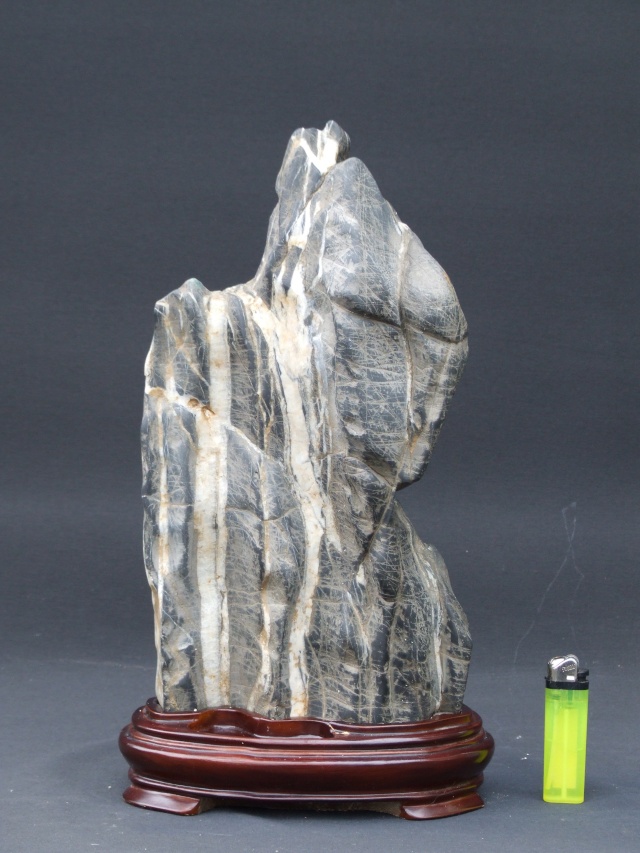
Back (the more I look at this the more it reminds me of the faces of the Easter Island standing stones
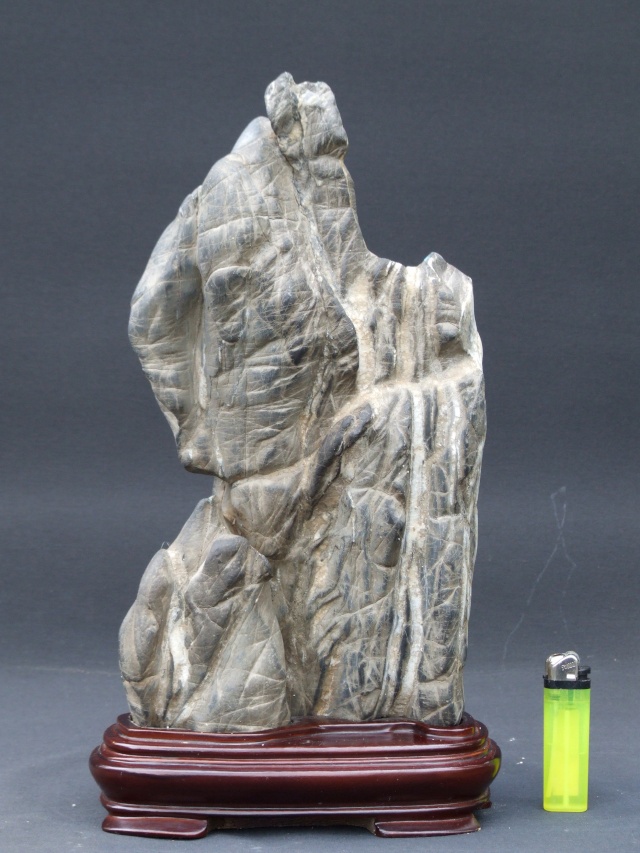
My expectations here are that I may have some decent stones but (if such a thing exists) at the cheap end of the market. I also suspect that while the stones are acceptable, the daiza may just be cheap and not bringing out the best in the stones.
Stone 1: I bought this because I liked the idea of a waterfall on a high mountain.
Front

Back (the more I look at this the more it reminds me of the faces of the Easter Island standing stones

Last edited by fiona on Wed Jul 20, 2011 6:10 pm; edited 1 time in total

fiona- Member
 Stones for beginners: Bought stones
Stones for beginners: Bought stones
Last edited by fiona on Wed Jul 20, 2011 6:10 pm; edited 1 time in total

fiona- Member
 Stones for beginners: Bought stones
Stones for beginners: Bought stones
Last edited by fiona on Wed Jul 20, 2011 6:10 pm; edited 1 time in total

fiona- Member
 Stones for beginners: Collected stones
Stones for beginners: Collected stones
I have a number of small commercially bought stones which I'll post later.
Now, some examples of stones I have picked up from beaches. This is perhaps the more important area for me; I am always concerned over on the tree forums on IBC about beginners who want to rush out and collect yamadori. The reason for this is that I know that, in their eagerness, there is a temptation to uproot anything and everything that looks like it might work (or is just small) and that inexperience often leads to completely inappropriate material being taken. So, to avoid similar widespread plundering of beaches, my question is what should I be looking for when beachcombing for stones?
Here are some I have picked up and my reasons for doing so (btw quite often my choice of mineral samples was on the basis of whether or not they "spoke" to me.)
Stone 5: collected on Islay. I loved the whorls of the stone (very common effect on stones on slay and the Clyde and Argyll shore lines). When stood on its end, it looked like a woman and child cameo brooch.
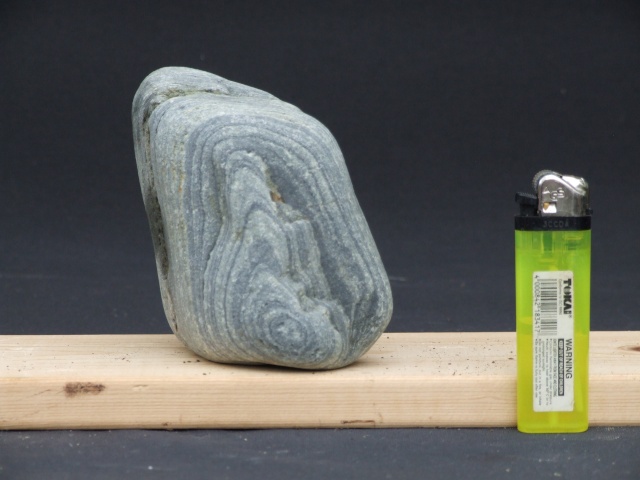
Could it be placed this way?

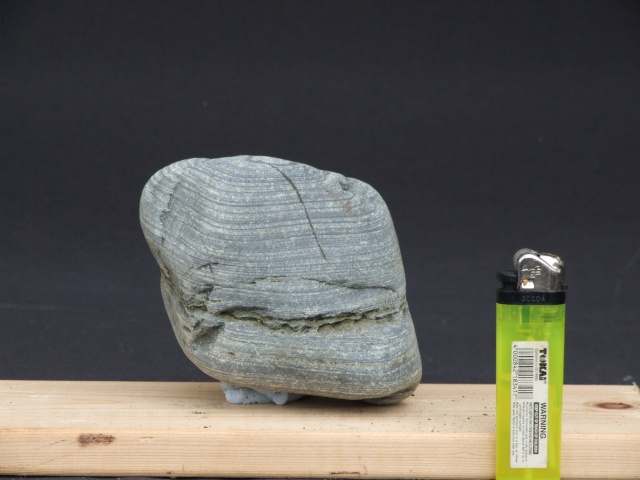
Stone 6: My own attempt at a tall mountain
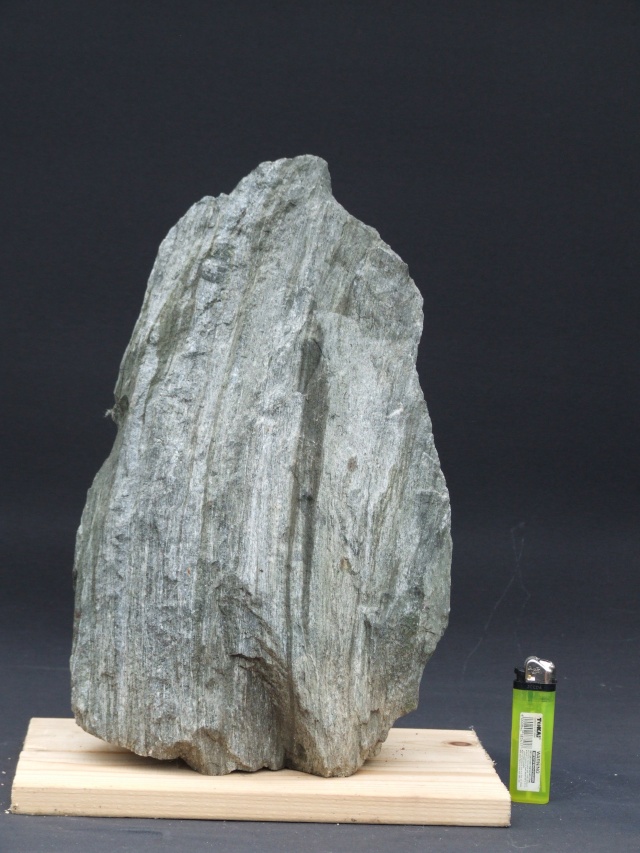
from the other side - it has that stone head appearance again.
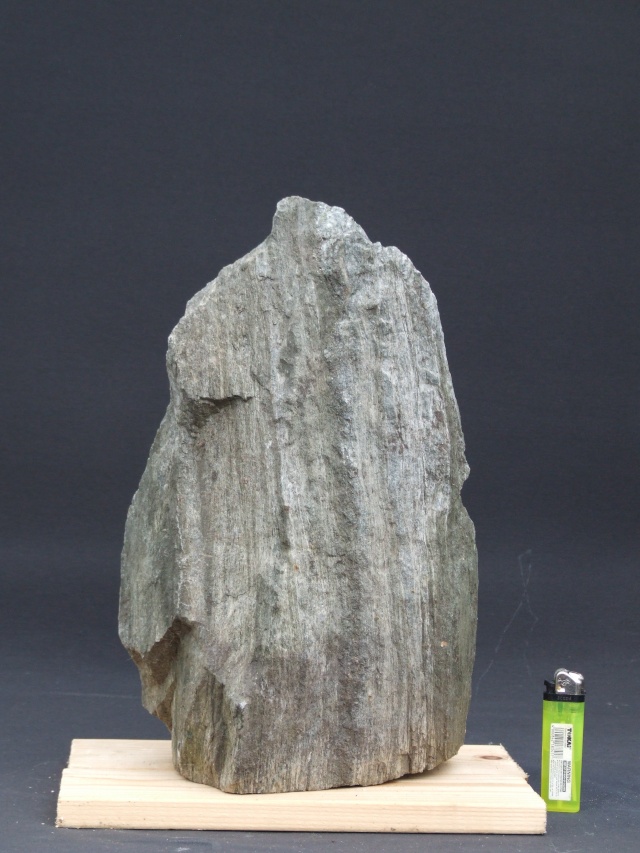
Now, some examples of stones I have picked up from beaches. This is perhaps the more important area for me; I am always concerned over on the tree forums on IBC about beginners who want to rush out and collect yamadori. The reason for this is that I know that, in their eagerness, there is a temptation to uproot anything and everything that looks like it might work (or is just small) and that inexperience often leads to completely inappropriate material being taken. So, to avoid similar widespread plundering of beaches, my question is what should I be looking for when beachcombing for stones?
Here are some I have picked up and my reasons for doing so (btw quite often my choice of mineral samples was on the basis of whether or not they "spoke" to me.)
Stone 5: collected on Islay. I loved the whorls of the stone (very common effect on stones on slay and the Clyde and Argyll shore lines). When stood on its end, it looked like a woman and child cameo brooch.

Could it be placed this way?


Stone 6: My own attempt at a tall mountain

from the other side - it has that stone head appearance again.

Last edited by fiona on Wed Jul 20, 2011 6:09 pm; edited 1 time in total

fiona- Member
 Stones for beginners: Collected stones
Stones for beginners: Collected stones
Last edited by fiona on Wed Jul 20, 2011 6:09 pm; edited 1 time in total

fiona- Member
 Re: Stones for beginners
Re: Stones for beginners
fiona wrote:Commercially Bought Stones (mostly from China)
My expectations here are that I may have some decent stones but (if such a thing exists) at the cheap end of the market. I also suspect that while the stones are acceptable, the daiza may just be cheap and not bringing out the best in the stones.
Stone 1: I bought this because I liked the idea of a waterfall on a high mountain.
Front
Back (the more I look at this the more it reminds me of the faces of the Easter Island standing stones
Dear Fiona
Many stones....I like most of them
In this stone I dont like the waterfall- approach, as a suiseki is not a waterfallstone, if the waterfall is on both sides.
I find the backside should be the front, as it is much more interesting, and I like your idea of the faces from the Easter Island lovely....the daiza is nice.
Kind regards Yvonne
Guest- Guest
 Re: Stones for beginners
Re: Stones for beginners
fiona wrote:Commercially bought stones:
Stone 2: mountain scene
Stone 3: I saw an abstract tree in this and have used it as such in a 5-tree shohin display
The mountainstone, is pretty, and a bit boring, as it looks to me, as the stone is cut. If the stone is not cut, do I find it much more interesting....the daiza is nice.
The treestone is pretty....The good thing about exhibiting stones or figurines together with shohindisplays, is, they are "for free"....if you use a kusamono, it will be one of the shohintrees ( 4 trees and a cusamono, is 5 trees)
And of top of this, must the kusamono have the right sice ( ca. half of the trees).
I have this information from a japanese exhibitor(expert)
Kind regards Yvonne
Guest- Guest
 Re: Stones for beginners
Re: Stones for beginners
fiona wrote:Commercially bought stones:
Stone 4 front: to be honest I just liked the shape
back:
This is one where the daiza is obviously inferior as the stone does not fit snugly.
This is two chinese shelterstones, with a nice shape...the daixas is OK, but they dont really highlight the stones, as the paterns of the daizas is rounded, and the stones are sharp.
kind regards Yvonne
Guest- Guest
 Re: Stones for beginners
Re: Stones for beginners
fiona wrote:I have a number of small commercially bought stones which I'll post later.
Now, some examples of stones I have picked up from beaches. This is perhaps the more important area for me; I am always concerned over on the tree forums on IBC about beginners who want to rush out and collect yamadori. The reason for this is that I know that, in their eagerness, there is a temptation to uproot anything and everything that looks like it might work (or is just small) and that inexperience often leads to completely inappropriate material being taken. So, to avoid similar widespread plundering of beaches, my question is what should I be looking for when beachcombing for stones?
Here are some I have picked up and my reasons for doing so (btw quite often my choice of mineral samples was on the basis of whether or not they "spoke" to me.)
Stone 5: collected on Islay. I loved the whorls of the stone (very common effect on stones on slay and the Clyde and Argyll shore lines). When stood on its end, it looked like a woman and child cameo brooch.
Could it be placed this way?
Stone 6: My own attempt at a tall mountain
from the other side - it has that stone head appearance again.
The first stone speaks to you, as you see the cameo brooch, and therefor is the first picture the way the stone should be shown, ( I also see your woman and child)
The tall "near mountain" stone may not really be usefull as suiseki, as resent knockoffs, disqualify stones.
But if you like the stone, keep it.
I prefer the bacside as the front.
Kind regards Yvonne
Guest- Guest
 Re: Stones for beginners
Re: Stones for beginners
Thanks for your thoughtful replies, Yvonne. May I ask a couple of follow-up questions please?
1. what does the term "cut stone" mean? I thought it just meant if the base of the stone had been cut flat. Does it refer to some sort of shaping of the stone by human hand rather than by nature?
2. what did you mean by "recent knockoffs" disqualifying stones?
Many thanks again for your input. Much appreciated.
Fiona
1. what does the term "cut stone" mean? I thought it just meant if the base of the stone had been cut flat. Does it refer to some sort of shaping of the stone by human hand rather than by nature?
2. what did you mean by "recent knockoffs" disqualifying stones?
Many thanks again for your input. Much appreciated.
Fiona

fiona- Member
 Re: Stones for beginners
Re: Stones for beginners
fiona wrote:Thanks for your thoughtful replies, Yvonne. May I ask a couple of follow-up questions please?
1. what does the term "cut stone" mean? I thought it just meant if the base of the stone had been cut flat. Does it refer to some sort of shaping of the stone by human hand rather than by nature?
2. what did you mean by "recent knockoffs" disqualifying stones?
Many thanks again for your input. Much appreciated.
Fiona
Dear Fiona
Your "distant mountain" stone is not bad at all, the shape is OK for a mountain....the reason why I think it was a cutstone, as soon as I saw it, was because of the stripes, they told me, it almost for sure was a stone cut.
Had it been plain black, would I not have been distracted by the stripes, saying cutstne, and I would have enjoyed it more.
The mountainshape was the part of a bigger stone, the finder wanted to highlight the pretty part, and cut off the rest, to make it fit into a daiza.
Stones found with a flat buttom, ready to go into a daiza, and actully have a shape, you can place in a catagori, has a high value, both in money and in esthetik ( sorry for the wrong spelling, but I dont find the word in my diktionary)
Also stones can be partcut, if only a small part of the stone needs to be removed, to fit it into a daiza....and then again, is some stones "manmade" they can be so heavy worked on, that they a close to fraud, this can be japanese hutstones, and chinese mountainstones.
The stones not worked on, is the most expensive stones, and in Japan they come with a box, and written on the box, is the name of the place, were the stone was found.
But cutstones is also collected, it is up to the finder/buyers purse, to decide.
Cutstones can be very pretty, but I prefer uncut stones.
"Resent Knockoffs" a stone has through the millions of years been shaped by the nature...it has maybe suffered many knockoffs, that gave the stone the interesting shape.....the knockoffs must be so old, they look like the stone was like this forever, the knockoffs must appear as old as the stone.
I hope this is some help to understand suiseki, or please ask again ( sorry for my poor inglish).....
Actully Fiona, I read your input in an another tread. About a stone you found looked like a biker.....I liked this stone very much, and saw it as a ""daruma" sitting, on maybe a log, hidden in the high grass".
This is maybe a more poetic approach to the subbject.
You are a european, and is free to see the things in stones you like, and maybe you dont have the japanese approach, I understand..... but if a stone mowes you, you can not ask for more, and it gives you all the reason in the world to enjoy it..... I love Japan a lot, and when I am in Japan, I am happy. The shape of a Torii-gate mowes me
I cant blame you, for not being zen enough, I call this " near mountain, with a platou" stone for toothace
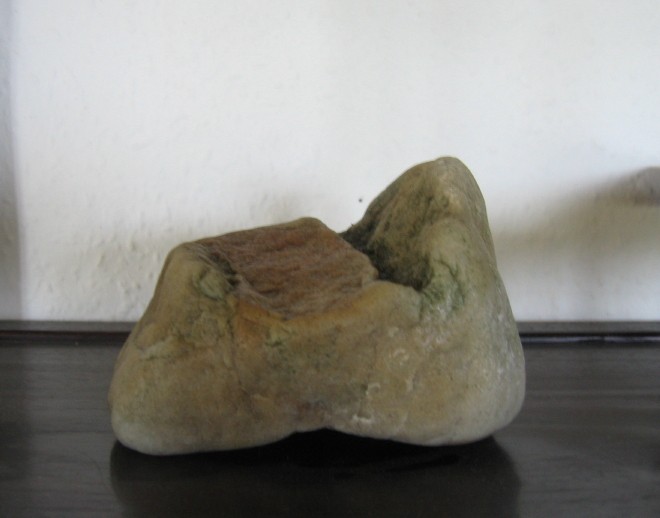
Guest- Guest
 Re: Stones for beginners
Re: Stones for beginners
Hi Fiona,
Hope things are well at your end and cheers to you,collecting stone are quite fun but is also requires a lot of imagination,i use ti collect lots but have found out that it serves more of a paper weight than anything else but l was lucky enough to have met a korean friend whose very good in suiseki & had learned a lot tru time,i personally like black river stone for it gives you more interpretation and are boundless in your mind.
but l was lucky enough to have met a korean friend whose very good in suiseki & had learned a lot tru time,i personally like black river stone for it gives you more interpretation and are boundless in your mind.
I am still learning a lot, for me i follow simple criteria....stones should have good texture (lots of character)....color should have distinctive composition....shape is a plus if you chance one....size should not exceed what you can't lift or be carry the most two person if it's heavy...Brittle & limestone volcanic the likes of it are for me NOT the right stone.
I hope it didn't confuse you more & happy hunting & hope you could post more,
Regards & take care,
Alex
Hope things are well at your end and cheers to you,collecting stone are quite fun but is also requires a lot of imagination,i use ti collect lots but have found out that it serves more of a paper weight than anything else
I am still learning a lot, for me i follow simple criteria....stones should have good texture (lots of character)....color should have distinctive composition....shape is a plus if you chance one....size should not exceed what you can't lift or be carry the most two person if it's heavy...Brittle & limestone volcanic the likes of it are for me NOT the right stone.
I hope it didn't confuse you more & happy hunting & hope you could post more,
Regards & take care,
Alex

ogie- Member
 Re: Stones for beginners
Re: Stones for beginners
Hi Fiona,
Some general thoughts from somebody who knows nothing about suiseki just picking up stones in a country with almost no stones.
To come to an educational approach is not easy.
Reading all pages on this forum and on the internet could be helpful.
Fiona's question is "where to look for, when collecting stones"?
Well you write "you pick up stones because they speak to you".
I feel that is important, with suiseki it is not about collecting minerals as such
but minerals that evoke something beyond that.
A lot of personal approaches are of course possible.
A stone can have all sorts of beauty, interesting character and story to tell,
one can look for things as shape, color, patterns, surface, the golden mean proportions and so on.
Or less subjective, do we pick up stones with the official suiseki categories in mind?
(this iconography might be helpful for the beginner or the professional collector
but only when one does nor forget that it is artificially)
In the end we may find, it is not about the actual stone but about our selves.
A further question could therefor be: does a stone evoke something you want to explore,
and can we do that with an open mind or is it only to poses that stone?
Or the question could be: why you want to collect stones?
Because it has something to do with the asian bonsai practice,
using tokonoma, scrolls, tables and pots?
Or to create a miniature world, placing, let say a miniature mountain in the scene?
Does suiseki appeal to us in such way that we like to find out
what is behind that asian practice of viewing stones?
Do we like to pass the esoteric line of wabi sabi
or do we only draw it in to the personal logic and feeling, and do we acknowledge that as a personal border?
One thing about wabi sabi is that it shows us the natural;
nothing artificially seems to have happened.
Being only natural and simple, it has the power to evoke the deeper mysteries in a person.
Beyond the external object, a stone can act as a mirror for true naturalness in the viewer.
(having said this, a stone can be very complicated and still simple)
A helping example could be the meaning of the Chinese characters,
they are not so strictly defined as the western words and letters.
For the Chinese, much depends on the situation and so on,
this shows us that the westerners approach things different compared to the eastern.
We tend to -fix name-, to determine a stone, (of course this happens in asia to)
it is necessary to a certain degree but this also means that a name is able to impair
our free reflection and appreciation of the suiseki,
certainly when after the reflection, we not let the image go for another view.
So a definition can shut the door to reflection of some part of reality,
can stop the fluid imagination.
(by giving it a name we protect our self for reality and deepening awareness.)
Having said this; to define something can prove helpful in the beginning,
it is however artificially, and therefor never leading to reality.
A key could be; do not fix, in that way we have the chance to learn every moment.
Apologies for so many words, i had not the time to write a short response.
regards, Sunip
Some general thoughts from somebody who knows nothing about suiseki just picking up stones in a country with almost no stones.
To come to an educational approach is not easy.
Reading all pages on this forum and on the internet could be helpful.
Fiona's question is "where to look for, when collecting stones"?
Well you write "you pick up stones because they speak to you".
I feel that is important, with suiseki it is not about collecting minerals as such
but minerals that evoke something beyond that.
A lot of personal approaches are of course possible.
A stone can have all sorts of beauty, interesting character and story to tell,
one can look for things as shape, color, patterns, surface, the golden mean proportions and so on.
Or less subjective, do we pick up stones with the official suiseki categories in mind?
(this iconography might be helpful for the beginner or the professional collector
but only when one does nor forget that it is artificially)
In the end we may find, it is not about the actual stone but about our selves.
A further question could therefor be: does a stone evoke something you want to explore,
and can we do that with an open mind or is it only to poses that stone?
Or the question could be: why you want to collect stones?
Because it has something to do with the asian bonsai practice,
using tokonoma, scrolls, tables and pots?
Or to create a miniature world, placing, let say a miniature mountain in the scene?
Does suiseki appeal to us in such way that we like to find out
what is behind that asian practice of viewing stones?
Do we like to pass the esoteric line of wabi sabi
or do we only draw it in to the personal logic and feeling, and do we acknowledge that as a personal border?
One thing about wabi sabi is that it shows us the natural;
nothing artificially seems to have happened.
Being only natural and simple, it has the power to evoke the deeper mysteries in a person.
Beyond the external object, a stone can act as a mirror for true naturalness in the viewer.
(having said this, a stone can be very complicated and still simple)
A helping example could be the meaning of the Chinese characters,
they are not so strictly defined as the western words and letters.
For the Chinese, much depends on the situation and so on,
this shows us that the westerners approach things different compared to the eastern.
We tend to -fix name-, to determine a stone, (of course this happens in asia to)
it is necessary to a certain degree but this also means that a name is able to impair
our free reflection and appreciation of the suiseki,
certainly when after the reflection, we not let the image go for another view.
So a definition can shut the door to reflection of some part of reality,
can stop the fluid imagination.
(by giving it a name we protect our self for reality and deepening awareness.)
Having said this; to define something can prove helpful in the beginning,
it is however artificially, and therefor never leading to reality.
A key could be; do not fix, in that way we have the chance to learn every moment.
Apologies for so many words, i had not the time to write a short response.
regards, Sunip
sunip- Member
 Re: Stones for beginners
Re: Stones for beginners
Hi Sunip.
Thank you for your very thoughtful and insightful response. Between you, you and Yvonne have confirmed several of my own thoughts. Interestingly, when I select mineral specimens I adopt a similar approach to the one you outline for stones. The vast majority of my collection of mineral samples (around 160) are bought. Therefore when I am faced with a selection of several of the same type, I always pick the one that somehow "speaks" to me. Yvonne (probably correctly) suggested that maybe I don't have a zen approach but I certainly do have an almost hippy/new age one in the case of minerals. Similarly when I am collecting stones on a beach, I will walk past many before I find the one that also speaks to me.
I didn't want to leave a response for too long, so once again thanks for your input. I am currently taking some more photos to post in response to some of the points Yvonne made. Watch this space as the cliché goes.
Fiona
Thank you for your very thoughtful and insightful response. Between you, you and Yvonne have confirmed several of my own thoughts. Interestingly, when I select mineral specimens I adopt a similar approach to the one you outline for stones. The vast majority of my collection of mineral samples (around 160) are bought. Therefore when I am faced with a selection of several of the same type, I always pick the one that somehow "speaks" to me. Yvonne (probably correctly) suggested that maybe I don't have a zen approach but I certainly do have an almost hippy/new age one in the case of minerals. Similarly when I am collecting stones on a beach, I will walk past many before I find the one that also speaks to me.
I didn't want to leave a response for too long, so once again thanks for your input. I am currently taking some more photos to post in response to some of the points Yvonne made. Watch this space as the cliché goes.
Fiona
Last edited by fiona on Fri Jul 22, 2011 12:55 pm; edited 1 time in total

fiona- Member
 Re: Stones for beginners
Re: Stones for beginners
Hopefully someone will correct me if this is worng but I am picking up that a poor option is for a stone to have been sawcut to give it a flat bottom, and that the better option is for the stone to be sunk into the daiza to give the appearance of a flat bottom.
How would this stone do in that light? I picked this one up a while ago as I liked its shape and colour and I saw a range of hills in it. The white bits made me think of snow patches rather than waterfalls, but it is also reminiscent of scottish hills criss-crossed with streams and paths.
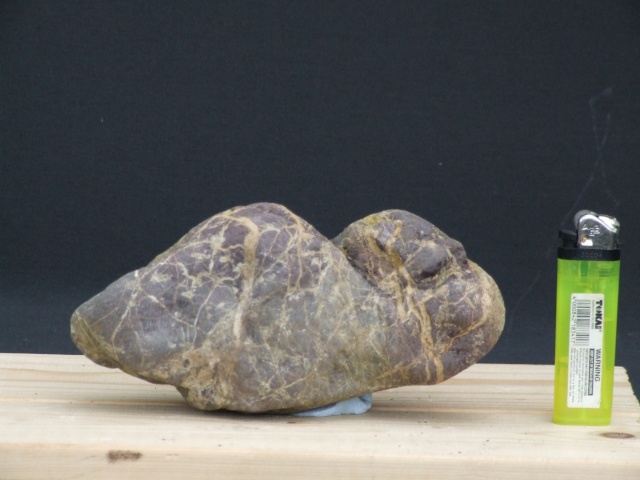
How would this stone do in that light? I picked this one up a while ago as I liked its shape and colour and I saw a range of hills in it. The white bits made me think of snow patches rather than waterfalls, but it is also reminiscent of scottish hills criss-crossed with streams and paths.


fiona- Member
 Re: Stones for beginners
Re: Stones for beginners
Hi Fiona
You are right, it is better not to cut the stone if possible....some sensitive people say a cutstone i dead. It is compleetely up to each person. I can enjoy a cutstone.....But then the cutstone must be very, very nice, and it was the only way to safe/keep this very nice part of the stone.
I have drawn a clumsy option for a daiza for you. I am sure there will be more options from other stonelowers, and they could verywell be better options.
Kind regards Yvonne

You are right, it is better not to cut the stone if possible....some sensitive people say a cutstone i dead. It is compleetely up to each person. I can enjoy a cutstone.....But then the cutstone must be very, very nice, and it was the only way to safe/keep this very nice part of the stone.
I have drawn a clumsy option for a daiza for you. I am sure there will be more options from other stonelowers, and they could verywell be better options.
Kind regards Yvonne

Guest- Guest
 Re: Stones for beginners
Re: Stones for beginners
Hi Fiona,
This stone gives me the image of a lying animal seen at the backside and looking
towards the viewer.
With is rounding's it has something female.
Cutting this stone, only to get a mountain image would be a loss indeed.
regards, Sunip
This stone gives me the image of a lying animal seen at the backside and looking
towards the viewer.
With is rounding's it has something female.
Cutting this stone, only to get a mountain image would be a loss indeed.
regards, Sunip
sunip- Member
 Re: Stones for beginners
Re: Stones for beginners
[/url][/quote]
Back (the more I look at this the more it reminds me of the faces of the Easter Island standing stones
[url=https://servimg.com/view/13643221/893]
Hi Fiona,
Now you put your own stone collecting as an example.
You bought a stone in the waterfall category
because you liked the idea.
As for some vertical streaming white lines, you may technically call it that way.
But for me, and like Ivonne said as well, it evokes no mountain waterfall.
The so called-backside- of the stone is however nice and rich on detail,
and i prefer this side because it gives me the feel of entity.
Now in what category we would have to place it in?
regards, Sunip
Back (the more I look at this the more it reminds me of the faces of the Easter Island standing stones
[url=https://servimg.com/view/13643221/893]

Hi Fiona,
Now you put your own stone collecting as an example.
You bought a stone in the waterfall category
because you liked the idea.
As for some vertical streaming white lines, you may technically call it that way.
But for me, and like Ivonne said as well, it evokes no mountain waterfall.
The so called-backside- of the stone is however nice and rich on detail,
and i prefer this side because it gives me the feel of entity.
Now in what category we would have to place it in?
regards, Sunip
sunip- Member
 Re: Stones for beginners
Re: Stones for beginners
Fiona,
I know you are asking about these specific stones because you want to make certain you are on the right path.
I will tell you that your open mind, your sincere desire to learn and search for answers tell me you are on the right path.
These stones are your stepping stones at the beginning of your journey, just like your first Bonsai were. Suiseki is but one
way of Stone appreciation, but it is the highest form. Tanseki, searching for Suiseki, is a journey on many levels.
You have the heart of a Poet which is perfect for Suiseki appreciation.
Best Regards,
Mark
I know you are asking about these specific stones because you want to make certain you are on the right path.
I will tell you that your open mind, your sincere desire to learn and search for answers tell me you are on the right path.
These stones are your stepping stones at the beginning of your journey, just like your first Bonsai were. Suiseki is but one
way of Stone appreciation, but it is the highest form. Tanseki, searching for Suiseki, is a journey on many levels.
You have the heart of a Poet which is perfect for Suiseki appreciation.
Best Regards,
Mark
Mark- Member
 Re: Stones for beginners
Re: Stones for beginners
Dear Fiona
Sunip and Mark, say it beatifull ....I have more problems with expressing my self.
....I have more problems with expressing my self.
Ofcourse you have the poetik side, maybe not the japanese , witch is the traditional, but a strong european ....to me it is understood, that every child or grown up, who picks up a stone, and find something in it, is a poet.
Entering the suisekiworld, is taking stones a bit further, the innocence may be a little lost, as you suddenly will know, some shapes and collors are more desired than others, you may take your stone to exhibition/competision....and trade will also be found. This is very much human behaviur.......In the last coupple of years, have I learned a lot about this issue. And I found, that I dont want to buy stones anymore. I have some, I love to bits, but will in the future only find my stones in the nature ( at least, I think so now:D )
In all this, I never lost the poetry....I think all stone- and suisekilovers has the poetry by nature.
I could write a lot more about this issue, as there is so much more to say, about so many more sides to it.
This is only a fraction.
Kind regards Yvonne
Sunip and Mark, say it beatifull
Ofcourse you have the poetik side, maybe not the japanese , witch is the traditional, but a strong european ....to me it is understood, that every child or grown up, who picks up a stone, and find something in it, is a poet.
Entering the suisekiworld, is taking stones a bit further, the innocence may be a little lost, as you suddenly will know, some shapes and collors are more desired than others, you may take your stone to exhibition/competision....and trade will also be found. This is very much human behaviur.......In the last coupple of years, have I learned a lot about this issue. And I found, that I dont want to buy stones anymore. I have some, I love to bits, but will in the future only find my stones in the nature ( at least, I think so now:D )
In all this, I never lost the poetry....I think all stone- and suisekilovers has the poetry by nature.
I could write a lot more about this issue, as there is so much more to say, about so many more sides to it.
This is only a fraction.
Kind regards Yvonne
Guest- Guest
 Re: Stones for beginners
Re: Stones for beginners
Actually, the more I look at this, the more it reminds me of one of my favourite historical artefacts - the Lewis Chessmen. Maybe that's what attracted me to it in the first place.
If you look, you can definitely see his eye and he has the same hunched position as the chessmen. Here is the link. The LewisChessmen

fiona- Member
Page 1 of 2 • 1, 2 
 Similar topics
Similar topics» Beginners help
» Beginners hornbeam
» Attention (N------s) Beginners in Bonsai :-)
» Geology for beginners
» Bonsai Books
» Beginners hornbeam
» Attention (N------s) Beginners in Bonsai :-)
» Geology for beginners
» Bonsai Books
Page 1 of 2
Permissions in this forum:
You cannot reply to topics in this forum









